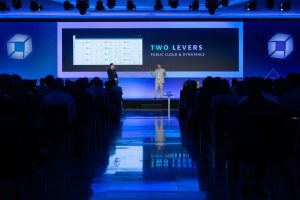Organizations are under pressure to reduce costs and speed products to market. To become more efficient, they have turned to technologies such as AIOps and IT automation.
As today’s macroeconomic environments grow increasingly competitive, organizations are under pressure to reduce costs and speed products to market. As they try to become more efficient, organizations are turning to technologies such as AIOps and IT automation.
AIOps—or the automation of IT operations—and other forms of IT automation have received increasing focus because these technology approaches are critical to improving organizational efficiency.

According to one recent survey, more than 60% of respondents were adopting AIOps to improve service and application availability and performance. Moreover, respondents chose automation of operations (58%) and processes (54%) as their second and third choices, respectively. Meanwhile, the greatest IT operations challenge for enterprises in 2023 was automating as many operations as possible, cited by 66% of respondents.
The path to IT automation: Cloud migration, tool consolidation
Boulogne Billancourt, France-based Odigo, for example, is using observability and IT automation to forward its mission: helping its global clients improve customer experience.
In its efforts to become more efficient, Odigo moved to public cloud architecture to speed its modernization and digital transformation. It also embraced observability technology using the Dynatrace platform to enable teams to peer into, and get a handle on, issues in their cloud environments. With Dynatrace, Odigo could establish a single version of truth rather than wrestle with alerts from multiple tools, which provided only a partial picture.
“We had to find a way to have our people working differently,” said Vincent Lascoux, chief operating officer, during a session on IT automation at the Dynatrace conference, in Barcelona, Spain. “We needed one solution to have all teams looking with the same eyes.”
But as many champions of AIOps and cloud observability can attest, the journey to organizational adoption is littered with siloed tools and a pressing need for tool consolidation.
According to Dynatrace data, only 14% of organizations have a unified, single monitoring platform to enable cross-team collaboration and a true understanding of IT’s business impact.
In the case of Odigo, the company had as many as 15 tools before adopting Dynatrace. Each team had its favorite tool—whether for networking, development, or database management—and Odigo needed to centralize.
“We asked [teams] to commit to decommission other tools,” Lascoux recalled. Odigo instituted a schedule for decommissioning tools. “We were having 10 or 15 tools key tools and we decreased that a lot with Dynatrace.”
Moving to proactive observability
After some months trying to standardize on certain dashboards, recounted Lascoux, Odigo was better positioned to understand complex customer environments. As he noted, gaining visibility into a customer’s environment poses greater challenges from gaining visibility into a company’s own environment.
“It’s much more complex to see the customer side: his own network, his own laptop. It can be much more complex to see how things are moving end to end,” Lascoux said.
But as Odigo gained greater visibility into customer issues and journeys, it streamlined the ability to identify issues and resolve them in customer environments.
“It simplifies the interaction between clients and technical teams,” Lascoux said, though he acknowledged that Odigo is still developing its strategies to identify client-side issues. “We still have work on that stage. It’s very complex to understand when we have an incident which clients will be affected.”
Ultimately, Lascoux said, Dynatrace, introducing AIOps and IT automation, enables Odigo to become more proactive and identify issues before they become problems.
“We can react even before we have an incident in our systems,” Lascoux said. “We can build some scripts and can change the application to react before we get into a critical situation.”
Using AIOps for digital transformation and customer experience
London, U.K.-based BT Group has also embraced IT automation to enable its goals: elevating customer experience (Cx) and remaining competitive.
BT Group is a telecommunications company amid a several-year digital transformation strategy. The company has 30 million consumer customers, 1-plus million business customers, and global operations in 180 countries. BT Group’s purpose is to “connect for good.” To forward that goal, BT focuses onproviding high-quality customer experiences and rapid response times.
“People want services instantly,” said Julian Stobbs, BT Group’s service insight and transformation director. “Mobile, broadband or data service, you want your service to be activated instantly. Customers also want to transact digitally. If those channels fail, we fail our customers. So, we are focusing on how to make things easy for the customer, but also instant,” he said.
But BT Group wants to do more than improve Cx. Stobbs said that the company aims to reduce its costs by 50% while simultaneously doubling its productivity.
“Like other telcos, we’re transforming to a ‘tech-co,’ so we’re modernizing, we’re simplifying our processes, our IT systems and our network,” he said.
But a couple of years ago, as BT Group adopted Dynatrace, its monitoring landscape was anything but simple. The company had 85 monitoring tools—15 of which were application monitoring tools.
“We started with 85 monitoring tools,” Stobbs said. “We had siloed business units. And no end-to-end visibility. We want to follow the customer journey, follow the service path. We didn’t have that visibility end to end,” Stobbs said.
AIOps yields results through reduced incidents, MTTR
Fast-forward to today, and BT Group is monitoring many of the 725 applications that represent 80% of “incident-generating applications.” The team has also developed 64 scenarios that can apply auto-remediation to these incidents. Further, it started to link the monitoring and service management platforms directly into its continuous integration/continuous development (CI/CD) platform, notifying developers directly when issues emerge.
When the Dynatrace platform identifies an incident, “that will pass into our service management system, which is ServiceNow,” Stobbs explained. “We will trigger auto-remediation to address those issues, and then [create] a feedback loop from Dynatrace,” he said. It also triggers a CI/CD notification via BT Group’s core CI/CD platform, iMobius, adding tasks directly into engineering backlogs via its tracking software, Jira.
As a result of its IT automation, AIOps, and auto-remediation efforts, Stobbs said, BT Group is “addressing 3.5% of incidents—that’s 500 incidents a week we are automating.”
But as Stobbs noted, there is an even more telling statistic thar reflects the impact of automation at BT Group: mean time to remediation, or MTTR.
While MTTR which reflects the time to address an incident, it has gone from roughly two hours 85 seconds.
Moreover, today, observability is now woven into the fabric of how BT operates and innovates. “Whenever we launch new products or systems, we design [monitoring] in from day one,” Stobbs said. “Every time a service launches or changes, Dynatrace is monitoring that service. Teams are getting real-time feedback when they pilot services.”
IT automation and auto-remediation has changed how BT Group develops its services to ensure performance, solid customer experience, and real-time information for all teams.
The next step for BT Group is developing additional customer journeys with Dynatrace Grail. “We have logs, events that are more technical in nature augmented with the business context. . . . Bringing those together and overlaying with AI” is key over the next few years for the Group.
Follow the Dynatrace Innovate Barcelona page.
Check out our webinar on BT’s journey to automation here.



Looking for answers?
Start a new discussion or ask for help in our Q&A forum.
Go to forum